Facile Construction of Carboxyl-Functionalized Ionic Polymer towards Synergistic Catalytic Cycloaddition of Carbon Dioxide into Cyclic Carbonates
Abstract
:1. Introduction
2. Results and Discussion
2.1. Preparation and Characterization of the Polymers
2.2. Catalytic Performance
2.3. Plausible Reaction Mechanism
3. Methods and Materials
3.1. Chemicals
3.2. Synthesis of PIMBr, PIMBr-OH and PIMBr-COOH
3.3. Catalytic Performance
3.4. Characterization
3.5. DFT Calculation
4. Conclusions
Author Contributions
Funding
Institutional Review Board Statement
Informed Consent Statement
Data Availability Statement
Conflicts of Interest
References
- Zhang, Z.E.; Pan, S.Y.; Li, H.; Cai, J.C.; Olabi, A.G.; Anthony, E.J.; Manovic, V. Recent advances in carbon dioxide utilization. Chem. Rev. 2020, 125, 109799–109861. [Google Scholar] [CrossRef]
- Artz, J.; Müller, T.E.; Thenert, K.; Kleinekorte, J.; Meys, R.; Sternberg, A.; Bardow, A.; Leitner, W. Sustainable conversion of carbon dioxide: An integrated review of catalysis and life cycle assessment. Chem. Rev. 2018, 118, 434–504. [Google Scholar] [CrossRef] [PubMed]
- Truong, C.C.; Mishra, D.K. Recent advances in the catalytic fixation of carbon dioxide to value-added chemicals over alkali metal salts. J. CO2 Util. 2020, 41, 101252. [Google Scholar] [CrossRef]
- Yaashikaa, P.R.; Kumar, P.S.; Varjani, S.J.; Saravanan, A. A review on photochemical, biochemical and electrochemical transformation of CO2 into value-added products. J. CO2 Util. 2019, 33, 131–147. [Google Scholar] [CrossRef]
- Huang, K.; Zhang, J.Y.; Liu, F.; Dai, S. Synthesis of porous polymeric catalysts for the conversion of carbon dioxide. ACS Catal. 2018, 8, 9079–9102. [Google Scholar] [CrossRef]
- Rehman, A.; Nazir, G.; Rhee, K.Y.; Park, S.J. Electrocatalytic and photocatalytic sustainable conversion of carbon dioxide to value-added chemicals: State-of-the-art progress, challenges, and future directions. J. Environ. Chem. Eng. 2022, 10, 108219. [Google Scholar] [CrossRef]
- Aomchad, V.; Cristòfol, A.; Monica, F.D.; Limburg, B.; D’Elia, V.; Kleij, A.W. Recent progress in the catalytic transformation of carbon dioxide into biosourced organic carbonates. Green Chem. 2021, 23, 1077–1113. [Google Scholar] [CrossRef]
- Pescarmona, P.P. Cyclic carbonates synthesised from CO2: Applications, challenges and recent research trends. Curr. Opin. Green Sust. 2021, 29, 100457–100465. [Google Scholar] [CrossRef]
- Rehman, A.; Saleem, F.; Javed, F.; Ikhlaq, A.; Ahmad, S.W.; Harvey, A. Recent advances in the synthesis of cyclic carbonates via CO2 cycloaddition to epoxides. J. Environ. Chem. Eng. 2021, 9, 105113–105140. [Google Scholar] [CrossRef]
- Han, B.X.; Jiang, Y.F.; Sun, X.R.; Li, Z.F.; Li, G. Proton conductive N-heterocyclic metal–organic frameworks. Coord. Chem. Rev. 2021, 432, 213754–213792. [Google Scholar] [CrossRef]
- Zhou, H.; Wang, G.X.; Zhang, W.Z.; Lu, X.B. CO2 adducts of phosphorus ylides: Highly active organocatalysts for carbon dioxide transformation. ACS Catal. 2015, 5, 6773–6779. [Google Scholar] [CrossRef]
- Qi, C.; Chaemchuen, S.; Liu, M.; Wang, J.C.; Zhuiykov, S.; Verpoort, F. Metal embedded porous carbon for efficient CO2 cycloaddition under mild conditions. Catalysts 2022, 12, 427. [Google Scholar] [CrossRef]
- Guo, L.P.; Lamb, K.J.; North, M. Recent developments in organocatalysed transformations of epoxides and carbon dioxide into cyclic carbonates. Green Chem. 2021, 23, 77–118. [Google Scholar] [CrossRef]
- Zhang, W.L.; Ma, F.P.; Ma, L.; Zhou, Y.; Wang, J. Imidazolium-functionalized ionic hypercrosslinked porous polymers for efficient synthesis of cyclic carbonates from simulated flue gas. ChemSusChem 2020, 13, 341–350. [Google Scholar] [CrossRef] [PubMed]
- Luo, R.C.; Liu, X.Y.; Chen, M.; Liu, B.Y.; Fang, Y.X. Recent advances on imidazolium-functionalized organic cationic polymers for CO2 adsorption and simultaneous conversion into cyclic carbonates. ChemSusChem 2020, 13, 3945–3966. [Google Scholar] [CrossRef] [PubMed]
- Ebrahimi, A.; Rezazadeh, M.; Khosravi, H.; Rostami, A.; Al-Harrasi, A. An aminopyridinium ionic liquid: A simple and effective bifunctional organocatalyst for carbonate synthesis from carbon dioxide and epoxides. ChemPlusChem 2020, 85, 1587–1595. [Google Scholar] [CrossRef]
- Zou, Y.Z.; Ge, Y.S.; Zhang, Q.; Liu, W.; Li, X.G.; Cheng, G.E.; Ke, H.Z. Polyamine-functionalized imidazolyl poly(ionic liquid)s for the efficient conversion of CO2 into cyclic carbonates. Catal. Sci. Technol. 2022, 12, 273–281. [Google Scholar] [CrossRef]
- Bao, C.L.; Jiang, Y.C.; Zhao, L.Y.; Li, D.Z.; Xu, P.; Sun, J.M. Aminoethylimidazole ionic liquid-grafted MIL-101-NH2 heterogeneous catalyst for the conversion of CO2 and epoxide without solvent and cocatalyst. New J. Chem. 2021, 45, 13893–13901. [Google Scholar] [CrossRef]
- Zhang, X.; Geng, W.H.; Yue, C.T.; Wu, W.; Xiao, L.F. Multilayered supported ionic liquids bearing a carboxyl group: Highly efficient catalysts for chemical fixation of carbon dioxide. J. Environ. Chem. Eng. 2016, 4, 2565–2572. [Google Scholar] [CrossRef]
- Jiang, B.W.; Yan, X.Y.; Xu, Y.; Likhanova, N.; Velázquez, H.D.; Gong, Y.Y.; Yuan, Y.; Verpoort, F. Tandem reactions based on the cyclization of carbon dioxide and propargylic alcohols: Derivative applications of α-Alkylidene carbonates. Catalysts 2022, 12, 73. [Google Scholar] [CrossRef]
- Zhang, Y.; Yin, S.; Luo, S.; Au, C.T. Cycloaddition of CO2 to epoxides catalyzed by carboxyl-functionalized imidazolium-based ionic liquid grafted onto cross-linked polymer. Ind. Eng. Chem. Res. 2012, 51, 3951–3957. [Google Scholar] [CrossRef]
- Zhang, N.; Zou, B.; Yang, G.P.; Yu, B.; Hu, C.W. Melamine-based mesoporous organic polymers as metal-free heterogeneous catalyst: Effect of hydroxyl on CO2 capture and conversion. J. CO2 Util. 2017, 22, 9–14. [Google Scholar] [CrossRef]
- Ma, D.X.; Liu, K.; Li, J.X.; Shi, Z. Bifunctional metal-free porous organic framework heterogeneous catalyst for efficient CO2 conversion under mild and cocatalyst-free conditions. ACS Sustain. Chem. Eng. 2018, 6, 15050–15055. [Google Scholar] [CrossRef]
- Zhang, Y.Y.; Yang, G.W.; Xie, R.; Li, L.; Yang, B.; Wu, G.P. Scalable, durable, and recyclable metal-free catalysts for highly efficient conversion of CO2 to cyclic carbonates. Angew. Chem. Int. Ed. 2020, 132, 23491–23498. [Google Scholar] [CrossRef]
- Wan, Y.L.; Zhang, Z.M.; Ding, C.; Wen, L.L. Facile construction of bifunctional porous ionic polymers for efficient and metal-free catalytic conversion of CO2 into cyclic carbonates. J. CO2 Util. 2021, 52, 101673–101683. [Google Scholar] [CrossRef]
- Cokoja, M.; Wilhelm, M.E.; Anthofer, M.H.; Herrmann, W.A.; Kühn, F.E. Synthesis of cyclic carbonates from epoxides and carbon dioxide by using organocatalysts. ChemSusChem 2015, 8, 2436–2454. [Google Scholar] [CrossRef]
- Arayachukiat, S.; Kongtes, C.; Barthel, A.; Vummaleti, S.V.C.; Poater, A.; Wannakao, S.; Cavallo, L.G.; D’Elia, V. Ascorbic acid as a bifunctional hydrogen bond donor for the synthesis of cyclic carbonates from CO2 under ambient conditions. ACS Sustain. Chem. Eng. 2017, 5, 6392–6397. [Google Scholar] [CrossRef]
- Liu, M.S.; Wang, X.; Jiang, Y.C.; Sun, J.M.; Arai, M. Hydrogen bond activation strategy for cyclic carbonates synthesis from epoxides and CO2: Current state-of-the art of catalyst development and reaction analysis. Catal. Rev. 2018, 61, 214–269. [Google Scholar] [CrossRef]
- Ye, Y.F.; Li, D.Z.; Xu, P.; Sun, J.M. B-doped and NH2-functionalized SBA-15 with hydrogen bond donor groups for effective catalysis of CO2 cycloaddition to epoxides. Inorg. Chem. Front. 2020, 7, 3636–3645. [Google Scholar] [CrossRef]
- Hu, J.Y.; Ma, J.; Liu, H.A.; Qian, Q.L.; Xie, C.; Han, B.X. Dual-ionic liquid system: An efficient catalyst for chemical fixation of CO2 to cyclic carbonates under mild conditions. Green Chem. 2018, 20, 2990–2994. [Google Scholar] [CrossRef]
- Chudasama, S.J.; Shah, B.J.; Patel, K.M.; Dhameliya, T.M. The spotlight review on ionic liquids catalyzed synthesis of aza- and oxa-heterocycles reported in 2021. J. Mol. Liq. 2022, 361, 119664. [Google Scholar] [CrossRef]
- Yue, S.; Wang, P.P.; Hao, X.Y. Synthesis of cyclic carbonate from CO2 and epoxide using bifunctional imidazolium ionic liquid under mild conditions. Fuel 2019, 251, 233–241. [Google Scholar] [CrossRef]
- Zhou, X.J.; Weber, J.; Yuan, J.Y. Poly (ionic liquid)s: Platform for CO2 capture and catalysis. Curr. Opin. Green Sustain. Chem. 2019, 16, 39–46. [Google Scholar] [CrossRef]
- Zhang, J.W.; Li, X.P.; Zhu, Z.; Chang, T.; Fu, X.Y.; Hao, Y.J.; Meng, X.C.; Panchal, B.; Qin, S.J. Hydroxylamino—Anchored poly (ionic liquid)s for CO2 fixation into cyclic carbonates at mild conditions. Adv. Sustain. Syst. 2021, 5, 2000133–2000140. [Google Scholar] [CrossRef]
- Wang, Y.P.; Duan, J.X. Urea and thiourea-functionalized, pyridinium-based ionic polymers convert CO2 to cyclic carbonate under mild conditions. ACS Appl. Polym. Mater. 2022, 4, 5851–5860. [Google Scholar] [CrossRef]
- Liao, X.; Pei, B.Y.; Ma, R.X.; Kong, L.Z.; Gao, X.L.; He, J.; Luo, X.Y.; Lin, J.Q. Hypercrosslinked ionic polymers with high ionic content for efficient conversion of carbon dioxide into cyclic carbonates. Catalysts 2022, 12, 62. [Google Scholar] [CrossRef]
- Gou, H.B.; Ma, X.F.; Su, Q.; Liu, L.; Ying, T.; Qian, W.; Dong, L.; Cheng, W.G. Hydrogen bond donor functionalized poly (ionic liquid)s for efficient synergistic conversion of CO2 to cyclic carbonates. Phys. Chem. Chem. Phys. 2021, 23, 2005–2014. [Google Scholar] [CrossRef]
- Zhang, Y.D.; Chen, G.J.; Wu, L.; Liu, K.; Zhong, H.; Long, Z.Y.; Tong, M.M.; Yang, Z.Z.; Dai, S. Two-in-one: Construction of hydroxyl and imidazolium- bifunctionalized ionic networks in one-pot toward synergistic catalytic CO2 fixation. Chem. Commun. 2020, 56, 3309–3312. [Google Scholar] [CrossRef]
- Liu, D.; Kang, S.M.; Xu, Y.J.; Duan, P.G.; Chen, S.X. Core-shell catalyst with synergistic hydroxyl and nitrogen active sites for CO2 cycloaddition. J. Environ. Chem. Eng. 2021, 9, 106452–106459. [Google Scholar] [CrossRef]
- Zhang, Y.W.; El-Sayed, E.S.M.; Su, K.Z.; Yuan, D.Q.; Han, Z.B. Facile syntheses of ionic polymers for efficient catalytic conversion of CO2 to cyclic carbonates. J. CO2 Util. 2020, 42, 101301–101306. [Google Scholar] [CrossRef]
- Wang, Y.C.; Liu, Y.F.; Su, Q.; Li, Y.N.; Deng, L.L.; Dong, L.; Fu, M.Q.; Liu, S.F.; Cheng, W.G. Poly (ionic liquid) materials tailored by carboxyl groups for the gas phase-conversion of epoxide and CO2 into cyclic carbonates. J. CO2 Util. 2022, 60, 101976. [Google Scholar] [CrossRef]
- Yang, C.K.; Chen, Y.L.; Wang, X.; Sun, J.M. Polymeric ionic liquid with carboxyl anchored on mesoporous silica for efficient fixation of carbon dioxide. J. Colloid Interface Sci. 2022, 618, 44–55. [Google Scholar] [CrossRef]
- Liu, X.F.; Song, Q.W.; Zhang, S.; He, L.N. Hydrogen bonding-inspired organocatalysts for CO2 fixation with epoxides to cyclic carbonates. Catal. Today 2016, 263, 69–74. [Google Scholar] [CrossRef]
- Liu, M.S.; Zhao, P.H.; Zhang, W.W.; Cheng, X.; Fei, H.T.; Ma, J.J.; Liu, F.S. Rational self-assembly of triazine-and urea-functionalized periodic mesoporous organosilicas for efficient CO2 adsorption and conversion into cyclic carbonates. Fuel 2022, 315, 123230. [Google Scholar] [CrossRef]
- Jiang, Y.C.; Li, J.J.; Jiang, P.P.; Li, Y.; Leng, Y. Amino acid-paired dipyridine polymer as efficient metal-and halogen-free heterogeneous catalysts for cycloaddition of CO2 and epoxides into cyclic carbonates. Catal. Commun. 2018, 111, 1–5. [Google Scholar] [CrossRef]
- Guo, Z.J.; Cai, X.C.; Xie, J.Y.; Wang, X.C.; Zhou, Y.; Wang, J. Hydroxyl-exchanged nanoporous ionic copolymer toward low-temperature cycloaddition of atmospheric carbon cioxide into carbonates. ACS Appl. Mater. Inter. 2016, 8, 12812–12821. [Google Scholar] [CrossRef]
- Wang, Y.P.; Nie, J.Q.; Lu, C.F.; Wang, F.Y.; Ma, C.; Chen, Z.X.; Yang, G.C. Imidazolium-based polymeric ionic liquids for heterogeneous catalytic conversion of CO2 into cyclic carbonates. Microp. Mesop. Mater. 2020, 292, 109751–109756. [Google Scholar] [CrossRef]
- Li, Y.H.; Dominelli, B.; Reich, R.M.; Liu, B.P.; Kühn, F.E. Bridge-functionalized bisimidazolium bromides as catalysts for the conversion of epoxides to cyclic carbonates with CO2. Catal. Commun. 2019, 124, 118–122. [Google Scholar] [CrossRef]
- Ma, Z.Q.; Yang, Y.Y.; Ma, Q.Q.; Zhou, H.Z.; Luo, X.P.; Liu, X.H.; Wang, S.R. Evolution of the chemical composition, functional group, pore structure and crystallographic structure of bio-char from palm kernel shell pyrolysis under different temperatures. J. Anal. Appl. Pyrol. 2017, 127, 350–359. [Google Scholar] [CrossRef]
- Mao, P.; Dai, W.L.; Yang, W.Y.; Luo, S.L.; Zhang, Y.; Mao, J.; Luo, X.B.; Zou, J.P. Polymer nanoparticles grafted zinc-containing ionic liquids: A highly efficient and recyclable catalyst for cooperative cycloaddition of CO2 with epoxides. J. CO2 Util. 2018, 28, 96–106. [Google Scholar] [CrossRef]
- Chen, Y.J.; Luo, R.C.; Xu, Q.H.; Jiang, J.; Zhou, X.T.; Ji, H.B. Charged metalloporphyrin polymers for cooperative synthesis of cyclic carbonates from CO2 under ambient conditions. ChemSusChem 2017, 10, 2534–2541. [Google Scholar] [CrossRef] [PubMed]
- Liu, D.; Li, G.; Liu, H.O. Functionalized MIL-101 with imidazolium-based ionic liquids for the cycloaddition of CO2 and epoxides under mild condition. Appl. Surf. Sci. 2018, 428, 218–225. [Google Scholar] [CrossRef]
- Dai, W.L.; Jin, B.; Luo, S.L.; Yin, S.F.; Luo, X.B.; Au, C.T. Cross-linked polymer grafted with functionalized ionic liquid as reusable and efficient catalyst for the cycloaddition of carbon dioxide to epoxides. J. CO2 Util. 2013, 3, 7–13. [Google Scholar] [CrossRef]
- Chen, G.J.; Zhang, Y.D.; Xu, J.Y.; Liu, X.Q.; Liu, K.; Tong, M.M.; Long, Z.Y. Imidazolium-based ionic porous hybrid polymers with POSS-derived silanols for efficient heterogeneous catalytic CO2 conversion under mild conditions. Chem. Eng. J. 2020, 381, 122765–122775. [Google Scholar] [CrossRef]
- Jiang, B.; Wang, Y.M.; Zhang, L.H.; Sun, Y.L.; Yang, H.W.; Wang, B.Y.; Yang, N. Biodiesel production via transesterification of soybean oil catalyzed by superhydrophobic porous poly (ionic liquid) solid base. Energy Fuel. 2017, 31, 5203–5214. [Google Scholar] [CrossRef]
- Pan, H.; Li, H.; Liu, X.F.; Zhang, H.; Yang, K.L.; Huang, S.; Yang, S. Mesoporous polymeric solid acid as efficient catalyst for (trans) esterification of crude Jatropha curcas oil. Fuel Process. Technol. 2016, 150, 50–57. [Google Scholar] [CrossRef]
- Che, S.Y.; Yang, Z.Z.; Popovs, I.; Luo, H.M.; Luo, Y.L.; Guo, W.; Chen, H.; Wang, T.; Jie, K.C.; Wang, C.M.; et al. A succinct strategy for construction of nanoporous ionic organic networks from a pyrylium intermediate. Chem. Commun. 2019, 55, 13450–13453. [Google Scholar] [CrossRef]
- Yi, Q.; Liu, T.T.; Wang, X.B.; Shan, Y.Y.; Li, X.Y.; Ding, M.G.; Shi, L.J.; Zeng, H.B.; Wu, Y.C. One-step multiple-site integration strategy for CO2 capture and conversion into cyclic carbonates under atmospheric and cocatalyst/metal/solvent-free conditions. Appl. Catal. B 2021, 283, 119620–119656. [Google Scholar] [CrossRef]
- Li, J.; Jia, D.G.; Guo, Z.J.; Liu, Y.G.; Lyu, Y.; Zhou, Y.; Wang, J. Imidazolinium based porous hypercrosslinked ionic polymers for efficient CO2 capture and fixation with epoxides. Green Chem. 2017, 19, 2675–2686. [Google Scholar] [CrossRef]
- Zhang, Y.D.; Liu, K.; Wu, L.; Zhong, H.; Luo, N.; Zhu, Y.X.; Tong, M.M.; Long, Z.Y.; Chen, G.J. Silanol-enriched viologen-based ionic porous hybrid polymers for efficient catalytic CO2 fixation into cyclic carbonates under mild conditions. ACS Sustain. Chem. Eng. 2019, 7, 16907–16916. [Google Scholar] [CrossRef]
- Park, K.; Lee, K.; Kim, H.; Ganesan, V.; Cho, K.; Jeong, S.K.; Yoon, S. Preparation of covalent triazine frameworks with imidazolium cations embedded in basic sites and their application for CO2 capture. J. Mater. Chem. A 2017, 5, 8576–8582. [Google Scholar] [CrossRef]
- Wu, X.; Chen, C.T.; Guo, Z.Y.; North, M.; Whitwood, A.C. Metal- and halide-free catalyst for the synthesis of cyclic carbonates from epoxides and carbon dioxide. ACS Catal. 2019, 9, 1895–1906. [Google Scholar] [CrossRef]
- Chaugule, A.A.; Tamboli, A.H.; Kim, H. Ionic liquid as a catalyst for utilization of carbon dioxide to production of linear and cyclic carbonat. Fuel 2017, 200, 316–332. [Google Scholar] [CrossRef]
- Wilhelm, M.E.; Anthofer, M.H.; Cokoja, M.; Markovits, I.E.; Herrmann, W.A.; Kühn, F.E. Cycloaddition of carbon dioxide and epoxides using pentaerythritol and halides as dual catalyst system. ChemSusChem 2014, 7, 1357–1360. [Google Scholar] [CrossRef] [PubMed]
- Dong, T.F.; Zheng, Y.J.; Yang, G.W.; Zhang, Y.Y.; Li, B.; Wu, G.P. Crosslinked resin-supported bifunctional organocatalyst for conversion of CO2 into cyclic carbonates. ChemSusChem 2020, 13, 4121–4127. [Google Scholar] [CrossRef] [PubMed]
- Wang, X.C.; Zhou, Y.; Guo, Z.J.; Chen, G.J.; Li, J.; Shi, Y.M.; Liu, Y.Q.; Wang, J. Heterogeneous conversion of CO2 into cyclic carbonates at ambient pressure catalyzed by ionothermal-derived meso-macroporous hierarchical poly(ionic liquid)s. Chem. Sci. 2015, 6, 6916–6924. [Google Scholar] [CrossRef]
- Liu, M.S.; Zhao, P.H.; Gu, Y.Q.; Ping, R.; Gao, J.; Liu, F.S. Squaramide functionalized ionic liquids with well-designed structures: Highly-active and recyclable catalyst platform for promoting cycloaddition of CO2 to epoxides. J. CO2 Util. 2020, 37, 39–44. [Google Scholar] [CrossRef]
- Zhao, Y.L.; Huang, H.L.; Zhu, H.J.; Zhong, C.L. Design and synthesis of novel pyridine-rich cationic covalent triazine framework for CO2 capture and conversion. Microp. Mesop. Mater. 2022, 329, 111526. [Google Scholar] [CrossRef]
- Zhong, H.; Gao, J.W.; Sa, R.J.; Yang, S.L.; Wu, Z.C.; Wang, R.H. Carbon dioxide conversion upgraded by host-guest cooperation between nitrogen-rich covalent organic framework and imidazolium-based ionic polymer. ChemSusChem 2020, 13, 6323–6329. [Google Scholar]
- Shi, Z.J.; Su, Q.; Ying, T.; Tan, X.; Deng, L.L.; Dong, L.; Cheng, W.G. Ionic liquids with multiple active sites supported by SBA-15 for catalyzing conversion of CO2 into cyclic carbonates. J. CO2 Util. 2020, 39, 101162–101168. [Google Scholar] [CrossRef]
- Fedorova, I.V.; Safonova, L.P. Ab initio investigation of the interionic interactions in triethylammonium-based protic ionic liquids: The role of anions in the formation of ion pair and hydrogen bonded structure. J. Mater. Chem. A 2018, 123, 293–300. [Google Scholar] [CrossRef] [PubMed]
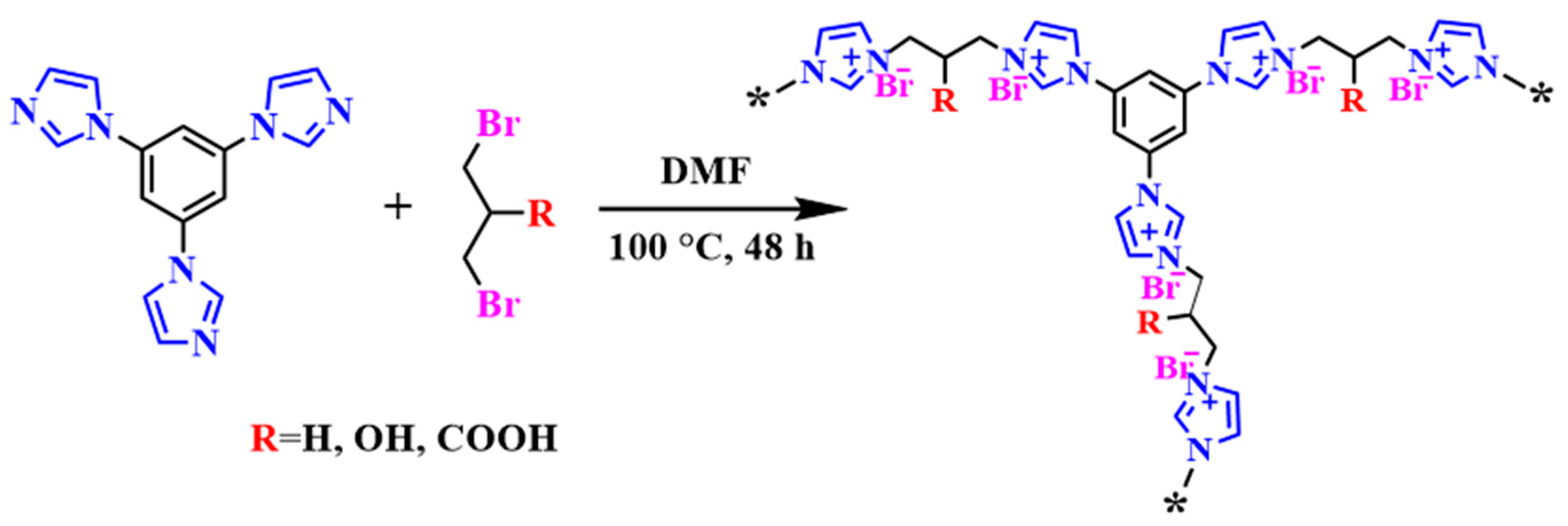
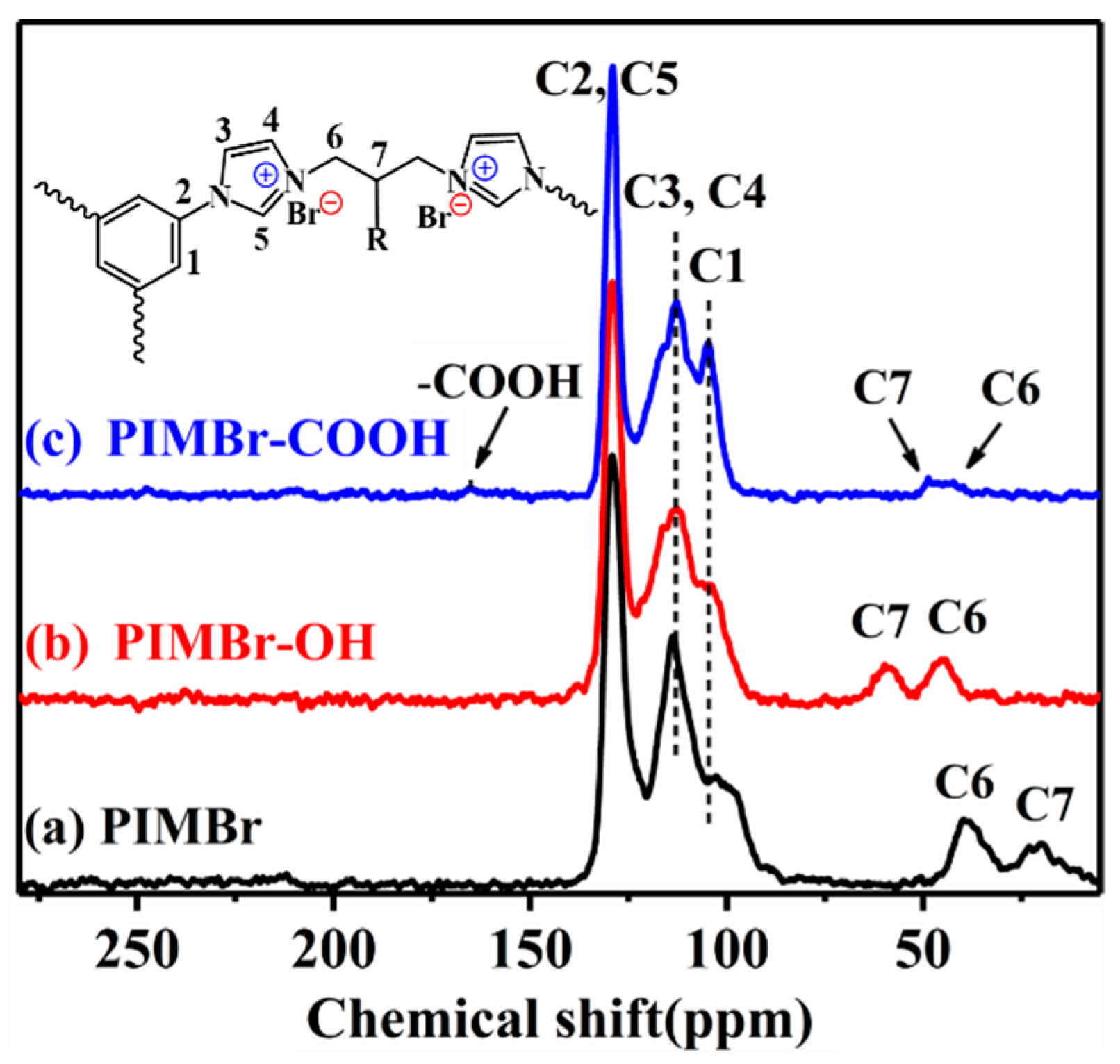

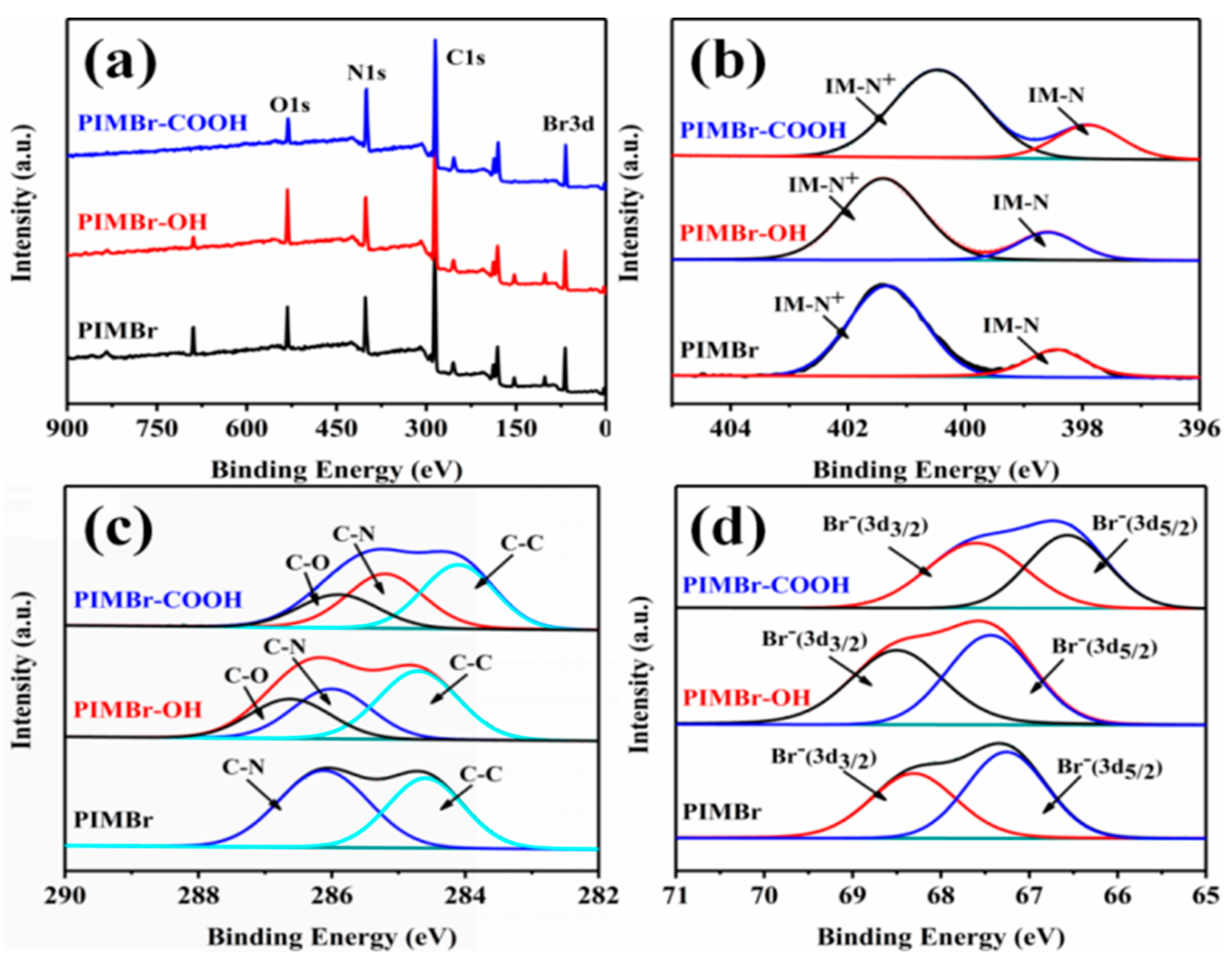
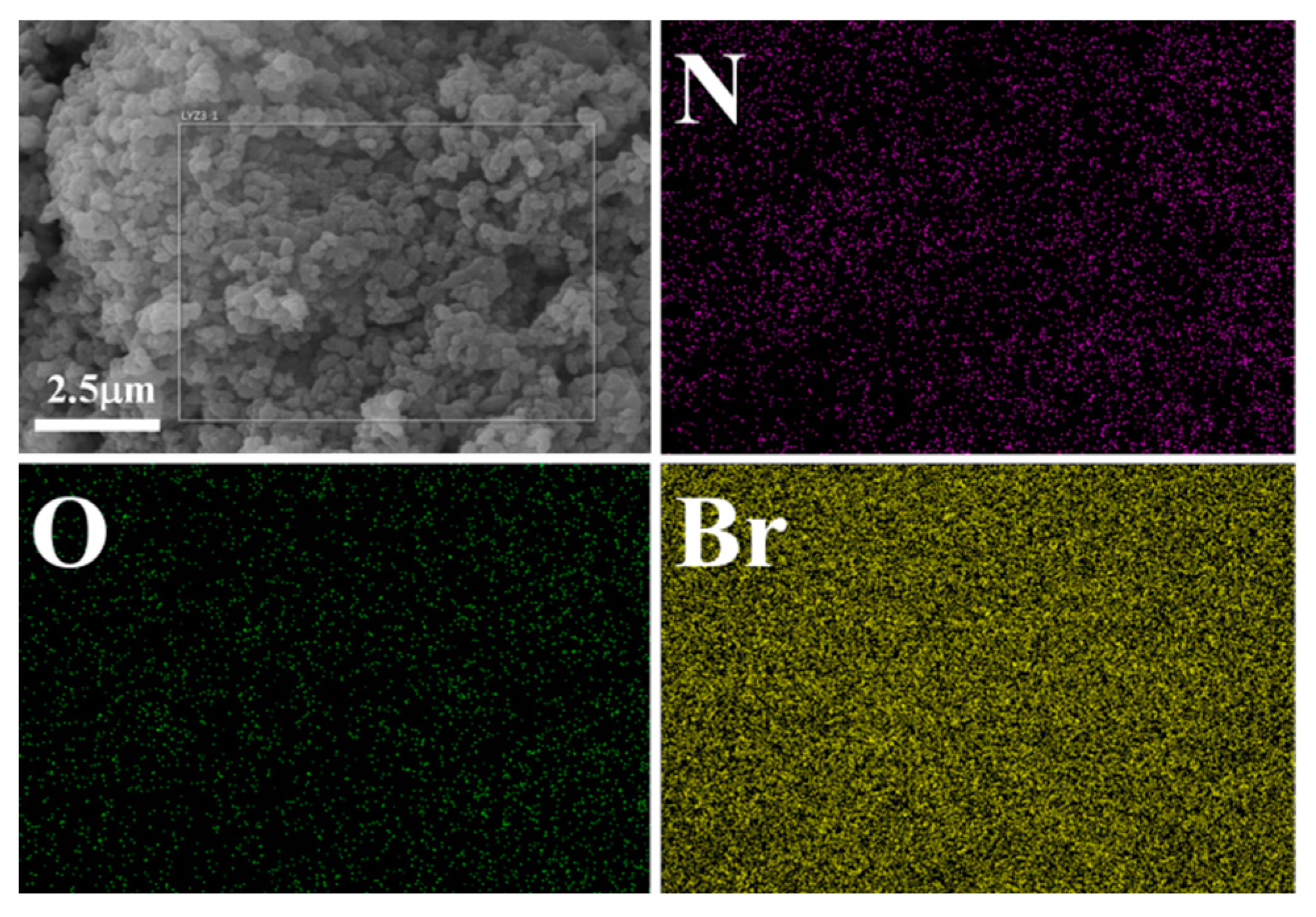
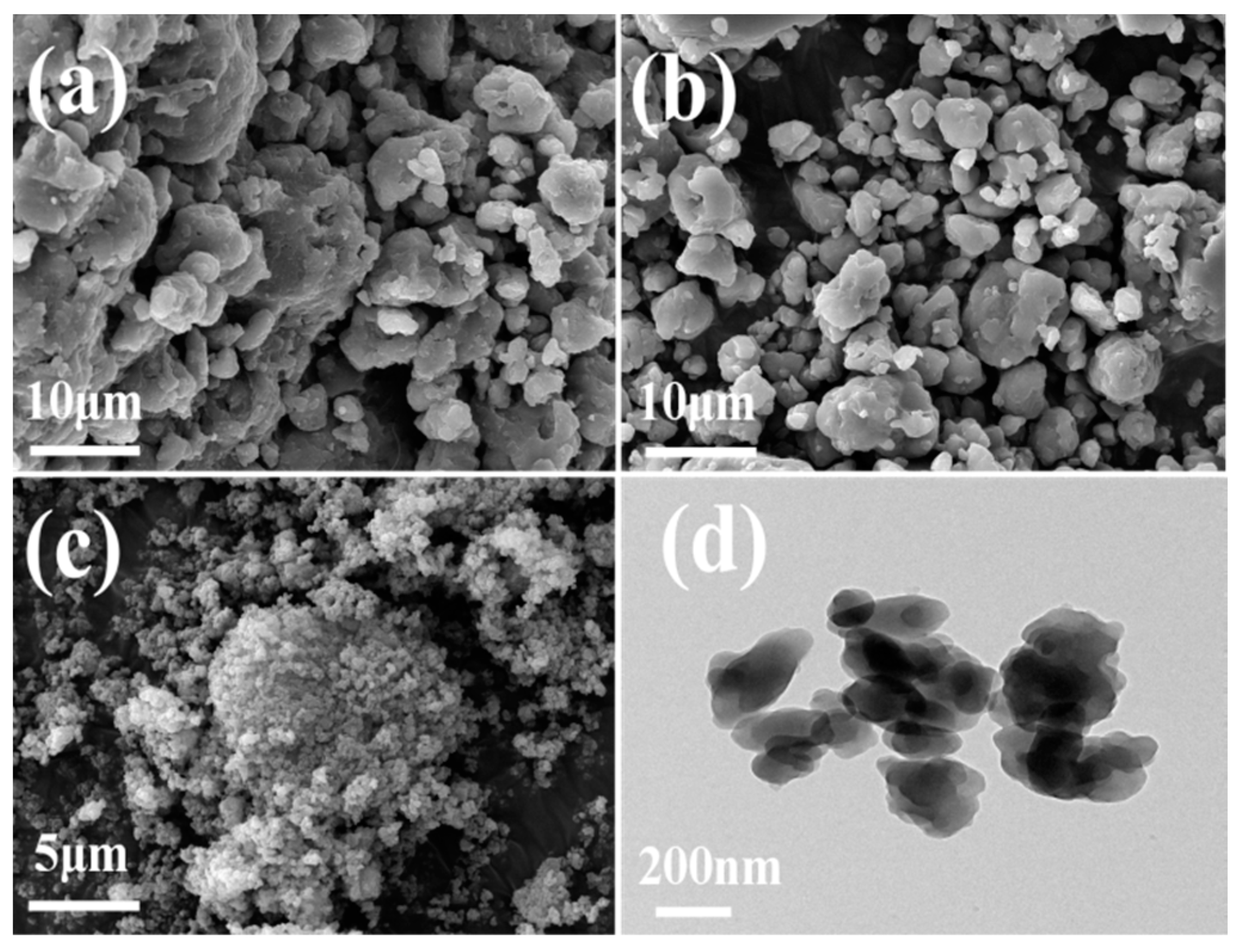

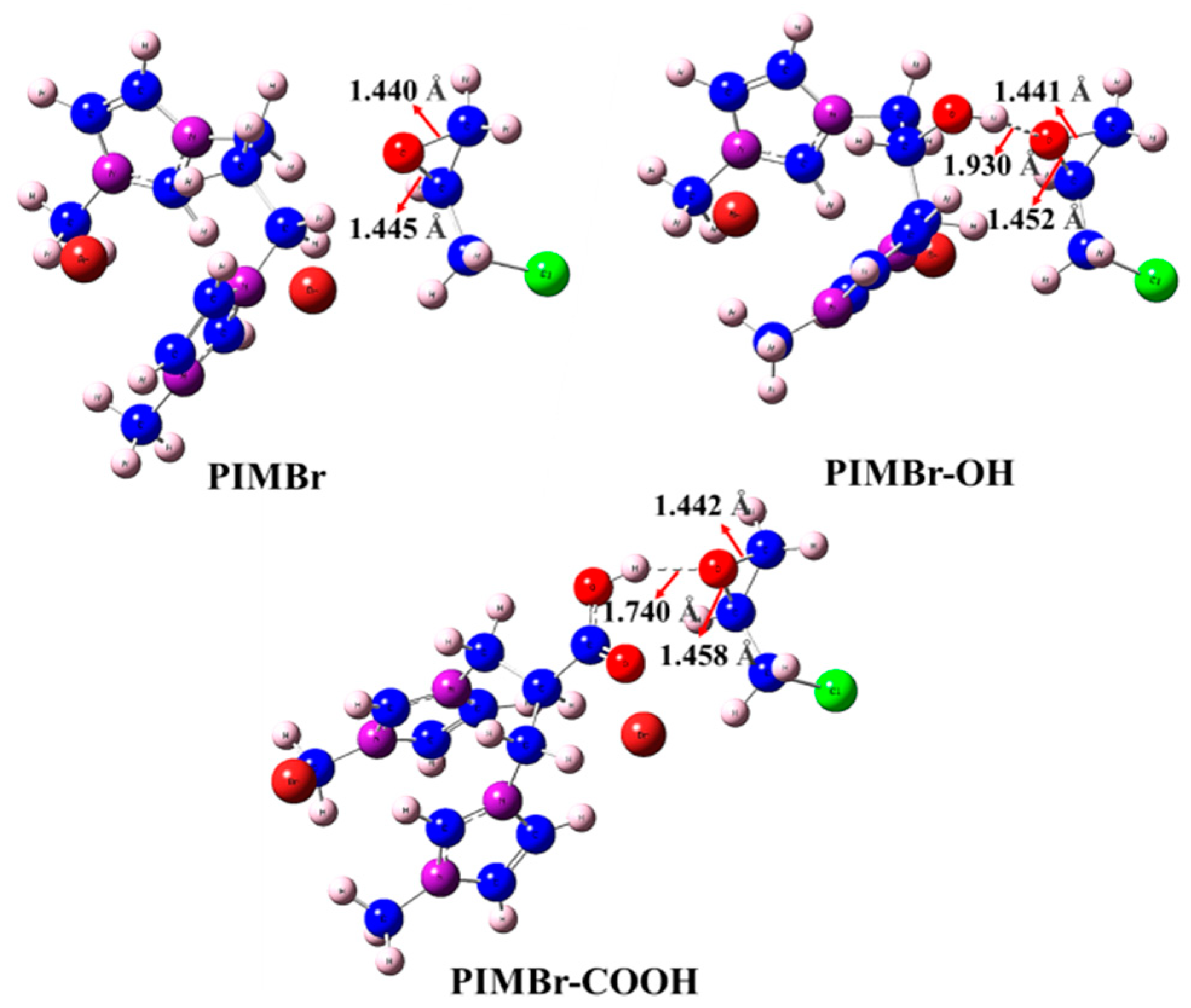
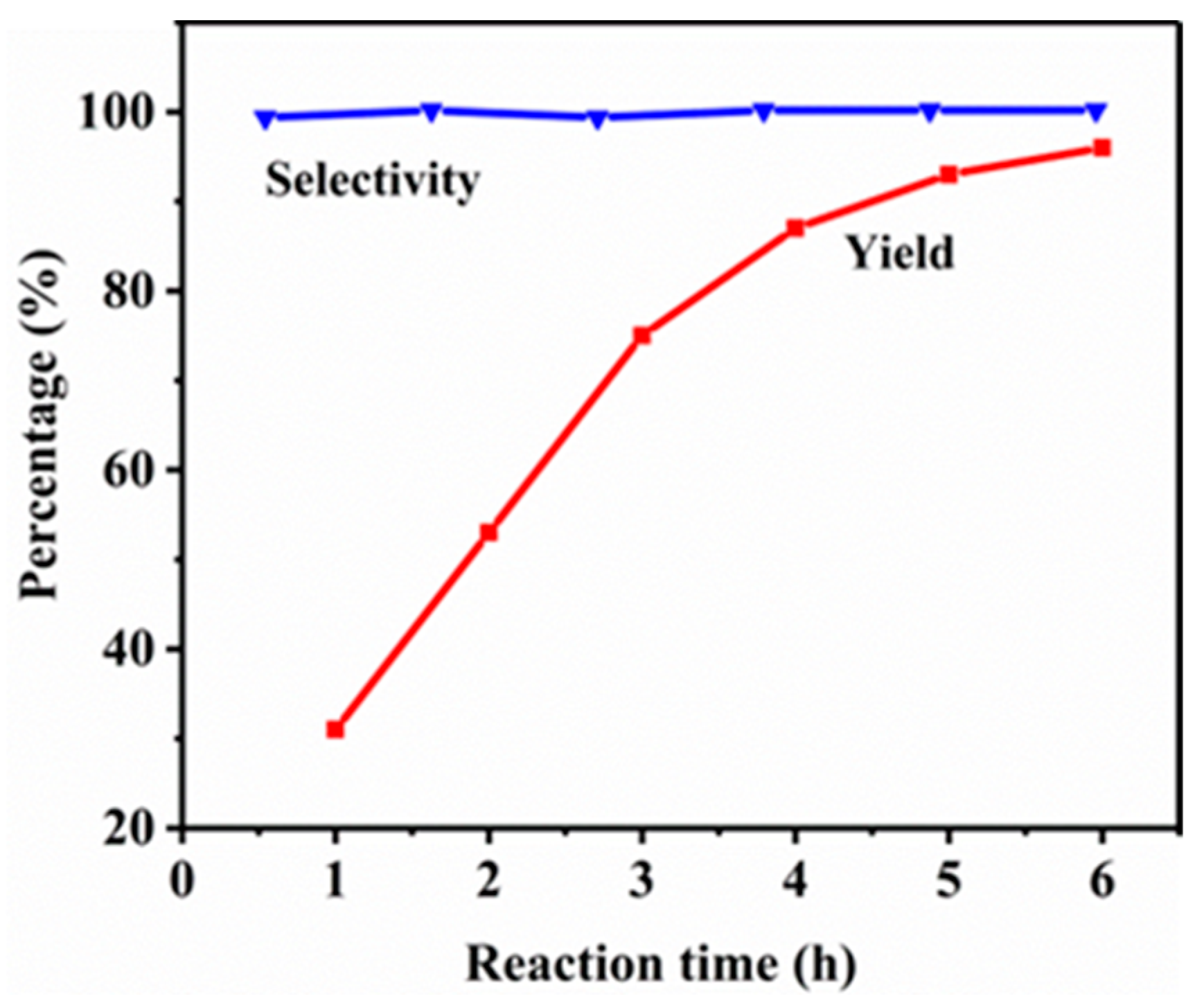
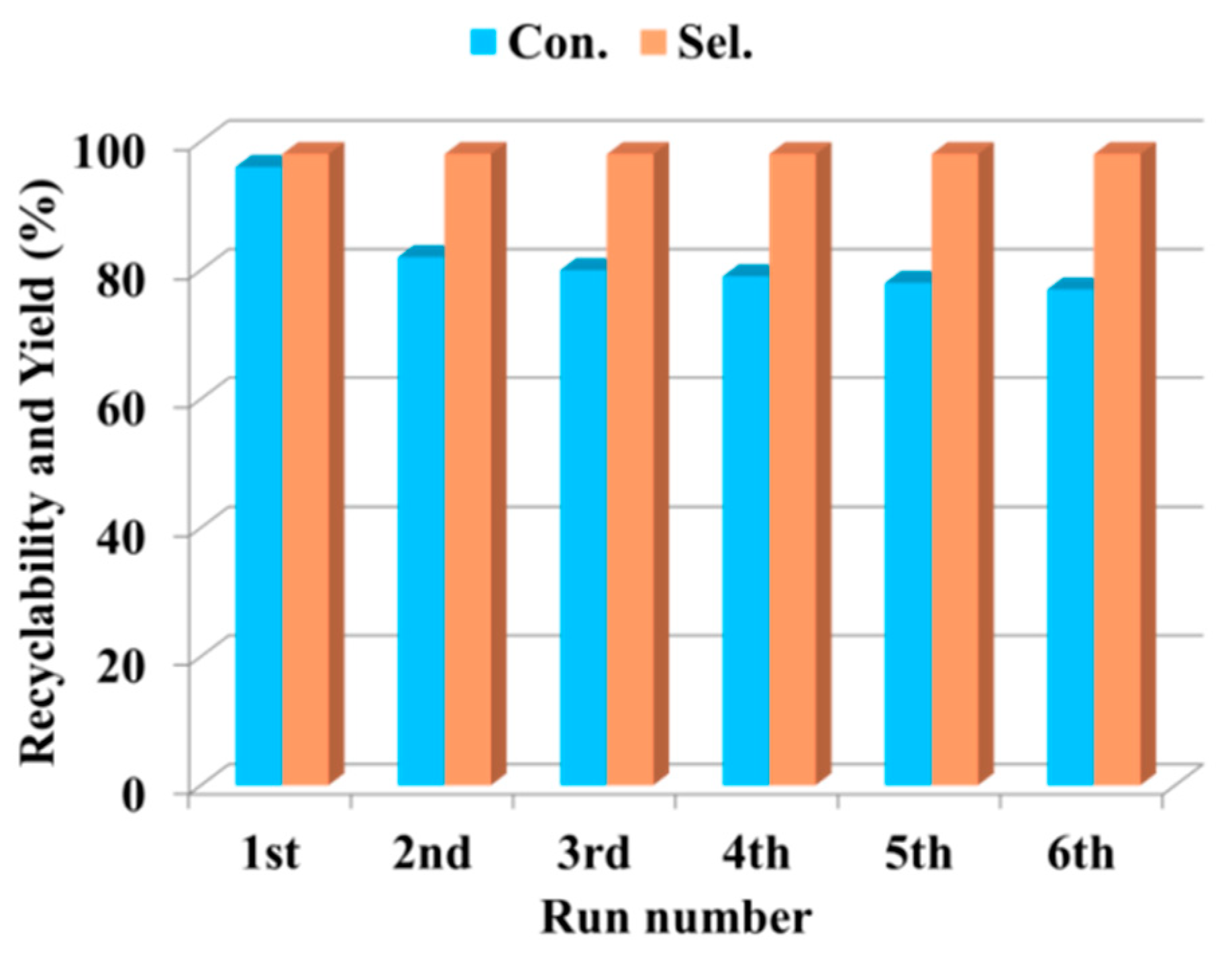
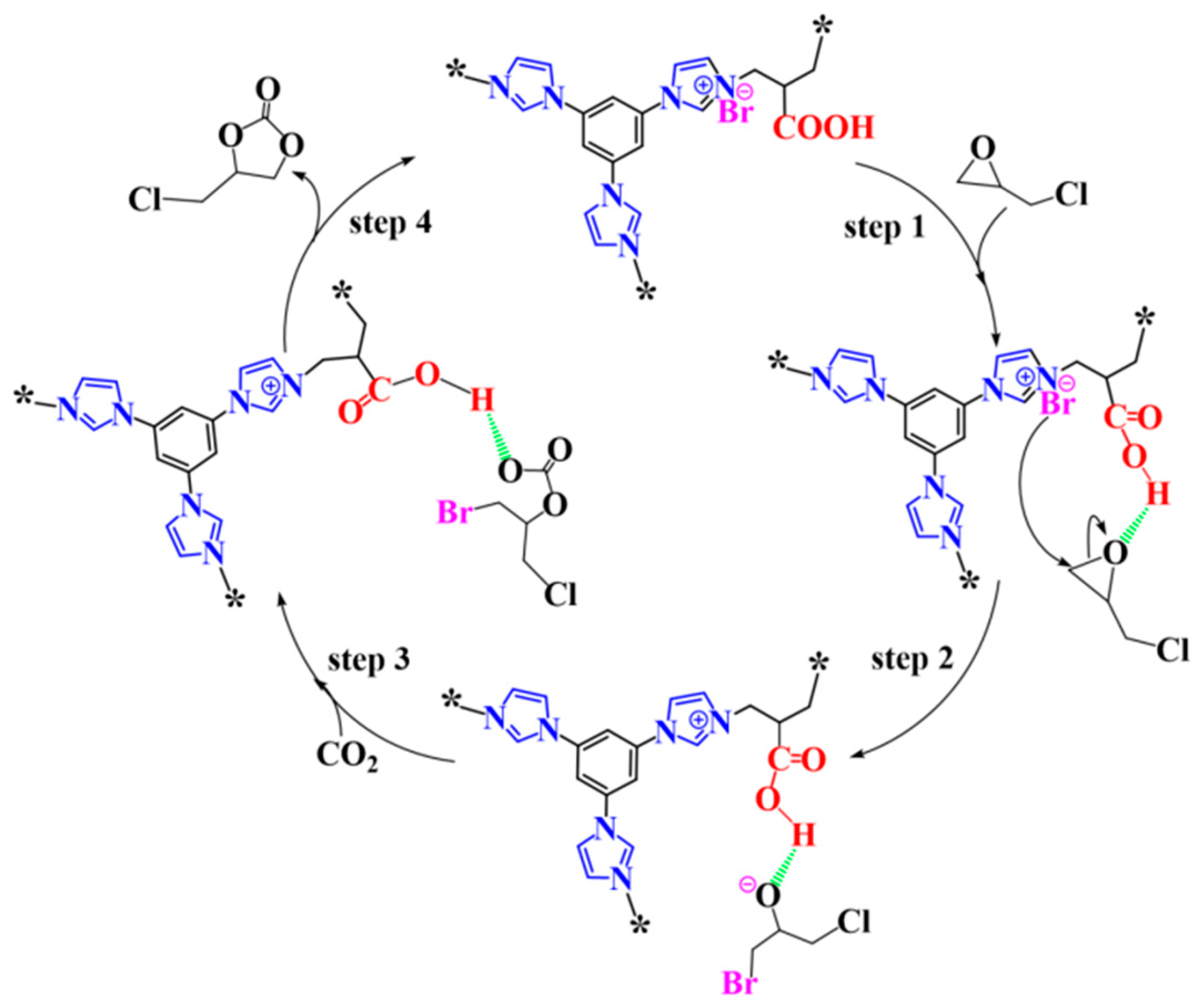
| Entry | Samples | SBET (m2·g−1) a | V (cm3 g−1) b | D (nm) c |
|---|---|---|---|---|
| 1 | PIMBr | 8.47 | 0.14 | 65.69 |
| 2 | PIMBr-OH | 11.20 | 0.15 | 54.89 |
| 3 | PIMBr-COOH | 36.51 | 0.28 | 30.90 |
 | |||
|---|---|---|---|
| Entry | Catalysts | Yield (mol%) b | Sel. (mol%) c |
| 1 | PIMBr | 54 | >99 |
| 2 | PIMBr-OH | 76 | >99 |
| 3 | PIMBr-COOH | 94 | >99 |
| Entry | Temp. (°C) | PCO2 (MPa) | Yield (mol%) b | Sel. (mol%) c |
|---|---|---|---|---|
| 1 | 60 | 1 | 4 | >99 |
| 2 | 80 | 1 | 44 | >99 |
| 3 | 100 | 1 | 94 | >99 |
| 4 | 100 | 0.5 | 90 | >99 |
| 5 | 100 | 0.25 | 82 | >99 |
| 6 | 100 | 0.1 | 77 | >99 |
| Entry | Catalysts | Epoxide a | Catal. Usage b | Conditions | Yield (mol%) | Reused Times | Ref. |
|---|---|---|---|---|---|---|---|
| 1 | PIMBr-COOH | ECH | 1 mol% | 100 °C, CO2 0.1 MPa, 6 h | 96 | 5 | This work |
| 2 | PCm3Lm1Nm2 | PO | 2 mol% | 100 °C, CO2 1.2 MPa, 8 h. | 79 | 4 | [65] |
| 3 | PDMBr | PO | 1.3 mol% | 110 °C, CO2 1 MPa, 4 h | 98.7 | 5 | [66] |
| 4 | SAIL-4 | PO | 3 mol% | 100 °C, CO2 1.5 MPa, 3 h | 99 | 5 | [67] |
| 5 | PQPBrCOOH | ECH | 1 mol% | 120 °C, CO2 0.1 MPa, 8 h | 97.8 | 8 | [25] |
| 6 | PIL-2 | ECH | 10 mg | 100 °C, CO2 1 MPa, 4 h | 81.2 | - | [17] |
| 7 | CTF-TPM-400 | ECH | 3 wt% | 100 °C, CO2 0.7 MPa, 24 h | 99 | 5 | [68] |
| 8 | ImIP@TT-COF | ECH | ~3.52 wt% | 120 °C, CO2 0.1 MPa, 10 h | 99 | 6 | [69] |
 | ||||
|---|---|---|---|---|
| Entry | R | T (h) | Yield (mol%) b | Sel. (mol%) |
| 1 | -CH2Br | 6 | 96 | >99 |
| 2 | -CH2O(CH2)3CH3 | 6 | 95 | >99 |
| 3 | -CH2OPh | 6 | 98 | >99 |
| 4 | -CH2OCH2Ph | 6 | 94 | >99 |
| 5 | -CH3 | 10 | 99 | >99 |
| 6 | -(CH2)3CH3 | 10 | 99 | >99 |
| 7 | -Ph | 6 | 90 | >99 |
Publisher’s Note: MDPI stays neutral with regard to jurisdictional claims in published maps and institutional affiliations. |
© 2022 by the authors. Licensee MDPI, Basel, Switzerland. This article is an open access article distributed under the terms and conditions of the Creative Commons Attribution (CC BY) license (https://creativecommons.org/licenses/by/4.0/).
Share and Cite
Chen, Y.; Li, Y.; Wang, H.; Chen, Z.; Lei, Y.-Z. Facile Construction of Carboxyl-Functionalized Ionic Polymer towards Synergistic Catalytic Cycloaddition of Carbon Dioxide into Cyclic Carbonates. Int. J. Mol. Sci. 2022, 23, 10879. https://doi.org/10.3390/ijms231810879
Chen Y, Li Y, Wang H, Chen Z, Lei Y-Z. Facile Construction of Carboxyl-Functionalized Ionic Polymer towards Synergistic Catalytic Cycloaddition of Carbon Dioxide into Cyclic Carbonates. International Journal of Molecular Sciences. 2022; 23(18):10879. https://doi.org/10.3390/ijms231810879
Chicago/Turabian StyleChen, Ying, Yingjun Li, Hu Wang, Zaifei Chen, and Yi-Zhu Lei. 2022. "Facile Construction of Carboxyl-Functionalized Ionic Polymer towards Synergistic Catalytic Cycloaddition of Carbon Dioxide into Cyclic Carbonates" International Journal of Molecular Sciences 23, no. 18: 10879. https://doi.org/10.3390/ijms231810879
APA StyleChen, Y., Li, Y., Wang, H., Chen, Z., & Lei, Y.-Z. (2022). Facile Construction of Carboxyl-Functionalized Ionic Polymer towards Synergistic Catalytic Cycloaddition of Carbon Dioxide into Cyclic Carbonates. International Journal of Molecular Sciences, 23(18), 10879. https://doi.org/10.3390/ijms231810879






